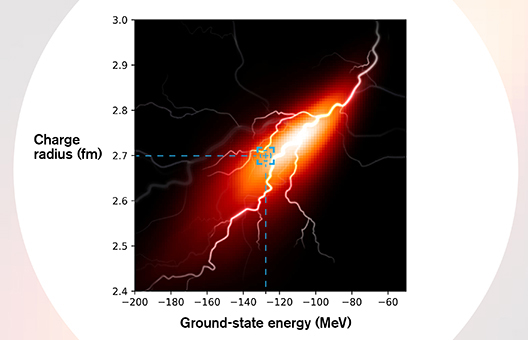A new mathematical approach called emulation dramatically decreases the amount of time necessary to solve equations describing key properties of atomic nuclei. The approach will help physicists run simulations far more quickly—and without the need for expensive and scarce supercomputing resources—to model the behavior of the strong nuclear interactions binding atomic nuclei together, deepening our understanding of this force of nature. See also: Atomic nucleus; Mathematics; Strong nuclear interactions; Supercomputer

Ordinarily, to model strong nuclear interactions, a computer must laboriously and repeatedly calculate complex many-body problems posed by interactions of protons and neutrons composing atomic nuclei. Because protons carry a positive electromagnetic charge, the particles repel each other. But at close proximity and in the presence of neutrons, the strong nuclear interaction overcomes the protons' electromagnetism, enabling stable nuclei—and, thus, chemical elements and the periodic table—to exist. One key way to advance our knowledge of the workings of the strong interaction—and, more broadly, of quantum mechanics, which describes matter's behavior on the smallest scales—is by studying the interaction's operation within a vast range of atomic nuclei. That range covers various isotopes of chemical elements, whose nuclei contain extra or fewer neutrons than the most commonly occurring version of the element. For example, the most common form of oxygen—oxygen-16 (16O)—contains eight protons and eight neutrons, while oxygen-17 and oxygen-18 contain one and two extra neutrons, respectively. Physicists often compare the energy level of an element alongside the element’s charge radius, or size, which reflects the strength of the strong nuclear interaction binding subatomic particles in the nucleus and overcoming protons' electromagnetic repulsion. See also: Chemical element; Electromagnetism; Energy level (quantum mechanics); Isotope; Neutron; Periodic table; Proton; Quantum mechanics
Seeking a shortcut to ramp up the number of simulations that can be run in a given time, researchers devised emulation, which is based on a computational method known as eigenvector continuation. This method starts by calculating a few exact solutions for the strong nuclear interaction's value, given certain parameters, and then uses those exact solutions to approximate solutions for other parameters. The technique delivers results that have 99% concordance with the traditionally arrived-at complete result, yet these results can be obtained in about an hour on a standard laptop computer, versus requiring 20 years' worth of equivalent computing time. Besides modeling atomic nuclei, emulation could benefit other investigations in particle physics, atomic physics, and astrophysics—such as the behavior of matter within neutron stars. See also: Eigenfunction; Eigenvalue (quantum mechanics); Neutron star





